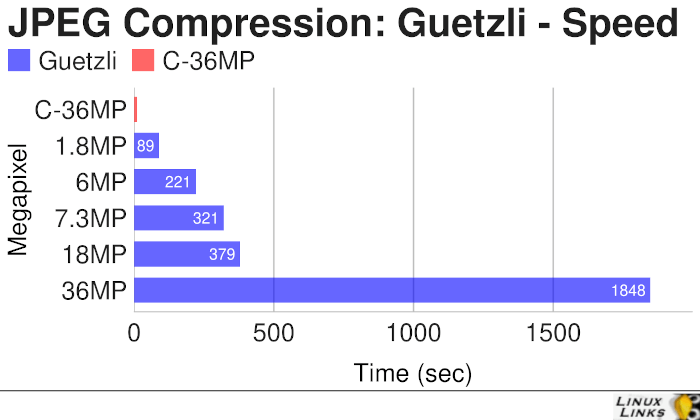Last Updated on July 22, 2020
Guetzli with time chart
Guetzli sacrifices encoding time. To illustrate the pedestrian nature of Guetzli, let’s test how long the encoding takes.
The chart below shows how long it takes to encode photographs with various MPs. Tests were performed using an Intel Core i5-2500K processor.

That’s correct, it took more than 30 minutes to encode a single 36 Megapixel JPEG image. Most image collections won’t be full of 36MP images of course. But even an 18MP image took more than 6 minutes to process. It’s incredibly CPU intensive.
You’re probably wondering about the mysterious C-36MP in the chart. That is MozJPEG (cjpeg) processing the 36MP image in a mere 7 seconds. Contrast that with Guetzli which takes 1,848 seconds. Wow!
Guetzli uses a single core. If your machine has lots of cores, you might think you could make significant time savings by running multiple instances of the software. But remember, Guetzli uses bucket loads of RAM when processing images with high MPs. For example, it peaked at over 5GB of RAM when tackling the 36MP image. You don’t want to be hitting swap when encoding.
Next page: MozJPEG – Compression charts
Pages in this article:
Page 1 – Introduction
Page 2 – Guetzli – Compression charts
Page 3 – Guetzli – Time chart
Page 4 – MozJPEG – Compression charts
Page 5 – MozJPEG – Time chart
Page 6 – Lepton – Compression charts
Page 7 – Lepton – Time chart
Page 8 – Summary

According to the tests I made some years ago to be able to store efficiently invoices and other enterprise documents scans into a document management software without artifacts, even on very small letters, tests that I also extended to web sites pictures processing, here is what I found :
using GIMP as the graphic manipulation program with a :
* progressive .jpg encoding for slow connections enabled,
* 4:4:4 Subsampling method,
* Floating-point for the DCT method,
* only exif data kept (no thumbnail or other orientation/dimensions system)
*** and the most important feature : image colors indexed into a 256 colors optimized palette,
the threshold not to cross to be absolutely sure there will be no artifacts in the final picture, nor color problems (except, of course, with gradations, that do not fit in this process) is : 65 %.
My 2¢